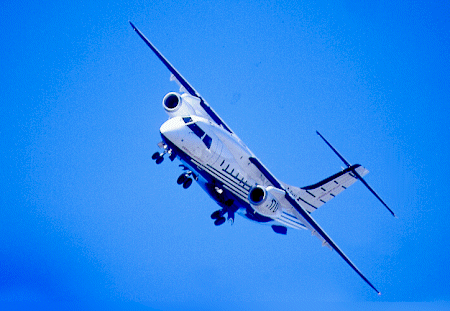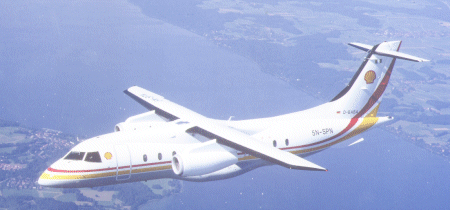Andrew Doyle/OBERPFAFFENHOFEN

It is an unconventional way of bringing a regional jet to the marketplace. Fairchild Aerospace has created a capable 30-seat aircraft by re-engining the Dornier 328 turboprop with turbofans. First deliveries of the 328JET were made to Skyway Airlines early last month.
The original 33-seat Pratt & Whitney Canada PW119-powered Dornier 328 first flew in December 1991 and was certificated in October 1993. Flight International published a cutaway drawing and full technical description in the 9-15 October, 1991, edition.
The Dornier 328, although a technical success, failed to live up to initial sales expectations. Only 109 have been ordered.
In early 1996, Dornier Luftfahrt's then parent, Germany's DaimlerChrysler Aerospace, decided to dispose of its loss-making regional aircraft subsidiary, and US manufacturer Fairchild Aerospace acquired 80% of the business in June of that year.
Within weeks of its take-over, Fairchild announced it was studying a turbofan-powered version of the 328. The selection of the 6,000lb-thrust (27kN) P&WC PW306B engine and formal launch of the 328JET followed in early 1997. The aircraft flew for the first time in January last year and received European and US certification this July.
The 328JET (flight test report, Flight International, 1-7 July, 1998) offers significantly improved performance over its turboprop predecessor, with maximum cruise speed increasing by 65kt (120km/h), to 400kt. The jet-powered version is capable of reaching its 31,000ft (9,450m) maximum cruising altitude from take-off at sea level in just 14.2 min.
Work is under way to raise the maximum cruising altitude of the 328JET to 35,000ft, to meet the requirements of an unnamed customer. This version could be certificated next year in tandem with a 454kg (1,000lb) increase in maximum take-off weight (MTOW).
The 328JET is offered in two versions - standard and high gross weight. The basic model has an MTOW of 15,200kg and a range of 1,370km (740nm), while the heavier aircraft is capable of 1,670km with its higher MTOW of 15,654kg. The latter also requires a slightly longer take-off and landing field length.
The first 328JET prototype was converted from a turboprop-powered example, which illustrates the degree of structural commonality between the 328JET and the original.
The structural changes introduced in the 328JET are relatively minor. Fuselage frames 24 and 26 - the wing and main landing gear frames, respectively - have been strengthened to cope with the new version's higher operating weights. The external dimensions of the wing and control surfaces are unchanged, as are the wing-fuselage attachments. A new engine pylon and pylon support bridge were needed to cope with the heavier PW306B engine.
"The wing had to be reinforced in some areas," says Dornier's chief engineer for high-wing aircraft programmes, J C Audet. This was achieved through localised strengthening of the upper wing panel and rear spar.
Changes were also required to some of the box ribs to accommodate larger-diameter fuel pipes to cater for the higher fuel consumption of the turbofans. In addition, the fuel capacity of the wing has been increased by 200litres (52USgal) by making full use of the internal height of the wing.
Redesign of the pylon support bridge, mounted forward of the wing structure, ensured that the existing pylon attachments could be used without the need to modify the wing's structure. "The advantage is that we have the same wing and ribs, so we can use the same tooling and the same production line," says Walter Ellinger, chief engineer for wing/tail on high-wing aircraft programmes.
"There is no change in the complete structure of the wing box. The loads are different, but easy to calculate for the stress guys," he adds. The higher powerplant weight and thrust were among factors which had to be considered in the calculations . These were mitigated by the lack of a reverse thrust capability on the turbofan the elimination of propeller torque effects and a dramatic cut in vibration levels.
Additional leading edge sections, known as 1A and 2A, have been added each side of the engine pylon to close the gaps opened by the elimination of the turboprop nacelle. Minor changes were also made to clean up the trailing edge behind the engine, says Ellinger. Another modification was made to the inboard trailing edge flap, which was extended 100mm (4in) rearwards to help increase operating speeds.
The minimum change philosophy also extends to the empennage, which is the same basic design as that on the 328 turboprop. The higher operating speeds of the 328JET, however, required some aerodynamic modifications. "We were trying to optimise drag reduction on the aircraft," says Audet. The angle of attack of the horizontal stabiliser has been changed to 0° from -1°, while local reinforcements have been added to its lower panels. The rudder trim tab is also larger, to cope with the increased thrust of the PW306Bturbofans.

Drag reduction measures
A horizontal plate has been installed on each side of the fin below the stabiliser on the 328JETto "delay compressibility buffet at those [higher] speeds", says Audet. Other drag reduction measures include improvements to the flap and control surface seals. The different aerodynamic characteristics of the 328JET, mainly due to the elimination of the propellers, have led to an increase in minimum approach speed (Vref) of more than 20kt, to 142kt.
The higher approach speeds, elimination of reverse thrust and the increased maximum take-off weight meant that the landing gear, wheels and brakes had to be upgraded. The Messier-Dowty undercarriage structure was reinforced and an extra set of Dunlop-supplied brake disks was added to deliver the required increase in braking energy. Another change was the addition of a single-wheel anti-skid braking system.
Dunlop was unable to deliver the enhanced wheels and brakes in time to meet Fairchild's flight test schedule, delaying the certification programme by a couple of months.
The 328JET's PW306B powerplant is a development of the PW306A business jet engine, certificated in 1995. Fairchild chief engineer propulsion - high wing, Siegfried Proske says: "The majority of changes were introduced in the high-pressure turbine to improve reliability and durability."
The PW306B has a five-stage high-pressure (HP) compressor (four axial, one centrifugal), two-stage HP turbine and three-stage low-pressure turbine. It is fronted by an 80cm-diameter, 22-bladed, wide-chord fan.
Other changes include the use of a dual-channel full-authority digital engine control (FADEC) and the addition of a second gearbox pad, driving an AC generator. Another requirement was to modify the configuration of the engine's accessories and dressings to reflect the fact that the powerplant is wing-mounted on the 328JET, rather than fuselage-mounted, as in its business jet applications.
Roy Corbin, P&WC project engineer, PW300 series engines, says: "Essentially, the basics of the turbomachinery are the same." Turbine temperatures in the PW306B at take-off power are a few hundred degrees hotter than the PW306A to optimise its performance for commuter-type, high-cycle operations. This has required the introduction of additional cooling in the HP turbine blades and vanes.
P&WC is responsible for the supply of the entire propulsion package, which includes a Nordam-produced nacelle. The 328JET's AlliedSignal 36-150 auxiliary power unit was used on the original 328.
Proske says one design goal for the 328JET was to keep engine/wing interface changes to a minimum, compared with the turboprop. "There were minor modifications for the jet pumps, which were adapted for the difference in fuel flow," he says. "There were no major changes to the basic layout of the fuel system."
The aircraft keeps the Honeywell Primus 2000-based integrated avionics system fitted to previous 328s, but Werner Kastiunig, system engineer - avionics, says that the move to turbofans and higher operating speeds means that every part of the avionics system has changes, although almost exclusively software related.
Definition of the required revisions to the avionics system took about one year to finish, says Kastiunig, after which "Honeywell modified the system to meet our requirements".
The powerplant change means that additional engine parameters have to be monitored and displayed in the cockpit, while additional fault warnings needed to be displayed.
The Honeywell flight management system (FMS) previously offered as an option for the turboprop, is fitted as standard to the jet, although a dual FMS installation will remain optional. Other equipment such as a traffic alert and collision avoidance system, global positioning system, airborne communications, addressing and reporting system and inertial reference system is also optional.
The 328JET has the same, three-abreast, 32-seat passenger cabin as the turboprop variant, although a redesigned cabin being developed for the 428JET will eventually be used on the smaller aircraft, based on the styling under development for the 728JET family.
Source: Flight International



















